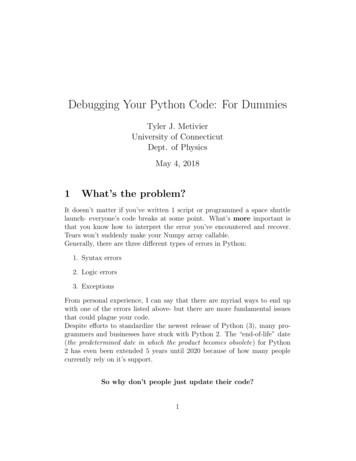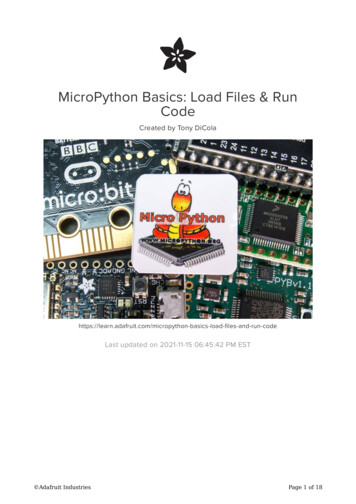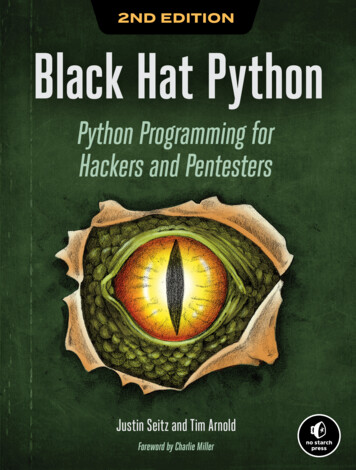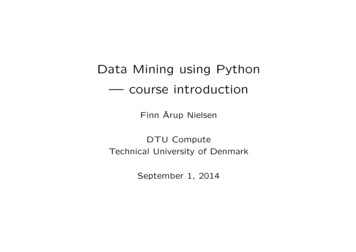
Transcription
Introduction to PythonSimon Andrews, Steven Wingettsimon.andrews@babraham.ac.uk@simon andrewsv2021-10
Setting up a Python Environment
Python is a ‘scripting’ language#!/usr/bin/env pythonprint("I am a python /www.python.org/C:\Introduction to Python python example.pyI am a python program
Different environments for writing python#!/usr/bin/env pythonprint("I am a python program")Scripted: code in text file, output in consoleC:\Users\andrewss\ pythonPython 3.9.1 (tags/v3.9.1:1e5d33e, Dec 7 2020,17:08:21) [MSC v.1927 64 bit (AMD64)] on win32Type "help", "copyright", "credits" or"license" for more information. print("I am an interactive session")I am an interactive session Interactive: code and output in consoleNotebook: code, commentary and output in asingle file
Using VSCode to write a python script Install VSCode Install Python interpreter Open VSCode– File New File– Select Python– File SaveAs Use a .py extension
Your first python program#!/usr/bin/env pythonmy name "Simon"print (my name,"wrote his first python program")print("He is very proud")C:\ "C:/Program Files/Python39/python.exe" "c:/Introduction to Python/first program.py"Simon wrote his first python programHe is very proud
Python script basicsWhere to find an interpreter#!/usr/bin/env pythonComments use ## Create a variable with my name in itSeries of python ‘statements’.my name "Simon"One per line (generally). Theseare executed in order, from theprint (my name,"wrote his first python program")top of the file to the bottom.Your program finishes at theend of the fileprint ("He is very proud")
Variables and Data Types A ‘variable’ is some data which you have given a name There are several different types of data structure– We’re starting with the ‘scalar’, a data type which holds a single value Python is a ‘dynamic’ but ‘strongly typed’ language– Dynamic You don’t need to say what type of data a variable will holdwhen you create it (and you can change it at any time)– Strongly typed Python tracks what type of data you have and changes itsbehaviour based on the type of the data
Creating a variable Variables are created or updated using the operator– ‘Operator’ just means special symbol– Variable ‘types’ are determined by the data used– Python style guide says "Variable names should be lowercase, withwords separated by underscores as necessary to improve readability"xxxx 55.5True"Simon"####xxxxisisisisan int (Integer, whole number)a float (Floating point number, fractional)a bool (Boolean, logical True/False)an str (String, piece of text)x input("What is your name? ") # Ask user for a str
Different ways to access functionality Operators– Special symbols to denote an operation (eg * / etc)5 10 Functions– Named pieces of functionality into which data is passedlen("simon") Methods– Functions which are accessed via the data directly"simon".upper()
Functions vs Methods Functions– Named pieces of code. All data (arguments)must be passed in to them. Accessed eitherin the core language or from packages len("Simon")5 Methods– Functions which are associated with a typeof data (string, date etc). Called via the data,you don’t need to pass the data in to themethod "Simon".upper()'SIMON'
Functions vs Methods FunctionCodeData MethodDataCode
Functionality is linked to data type 5 10 "5" "10"# 15# 510 "5".upper() 5.upper()# 5# SyntaxError: invalid syntax str(5) str(10) float("5") int(10)# "510"# 15
Common Numeric OperatorsOperator sionRaise to a powerFloor divisionModulo5 1023 - 5610 * 4.520 / 72 ** 520 // 720 % 7# Can mix int/float# Converts to float# Stays as int# Calculates remainder
Running a functionRound bracketsprint("Hello", "world", sep " ")Function namePositional ArgumentsNamed argument
How to use a function? help(print)Help on built-in function print in module builtins:print(.)print(value, ., sep ' ', end '\n', file sys.stdout, flush False)Prints the values to a stream, or to sys.stdout by default.Optional keyword arguments:file: a file-like object (stream); defaults to the current sys.stdout.sep:string inserted between values, default a space.end:string appended after the last value, default a newline.flush: whether to forcibly flush the stream.
List of built in pen()str()breakpoint()exec()isinstance() ord()sum()bytearray()filter()issubclass() repr()zip()compile()globals()map()reversed()import ()complex()hasattr()max()round()
Finding methods from data dir("some text")[' add ', ' class ', ' contains ', ' delattr ', ' dir ', ' doc ', ' eq ', ' format ',' ge ', ' getattribute ', ' getitem ', ' getnewargs ', ' gt ', ' hash ', ' init ',' iter ', ' le ', ' len ', ' lt ', ' mod ', ' mul ', ' ne ', ' new ', ' reduce ',' reduce ex ', ' repr ', ' rmod ', ' rmul ', ' setattr ', ' sizeof ', ' str ',' subclasshook ', 'capitalize', 'casefold', 'center', 'count', 'encode', 'endswith', 'expandtabs','find', 'format', 'format map', 'index', 'isalnum', 'isalpha', 'isascii', 'isdecimal', 'isdigit','isidentifier', 'islower', 'isnumeric', 'isprintable', 'isspace', 'istitle', 'isupper', 'join','ljust', 'lower', 'lstrip', 'maketrans', 'partition', 'removeprefix', 'removesuffix', 'replace','rfind', 'rindex', 'rjust', 'rpartition', 'rsplit', 'rstrip', 'split', 'splitlines', 'startswith','strip', 'swapcase', 'title', 'translate', 'upper', 'zfill'] help("some text".lower)Help on built-in function lower:lower() method of builtins.str instanceReturn a copy of the string converted to lowercase.Values looking like name are special, automatically created variables or methods. They're mostly forinternal use but we do sometimes use them directly
Finding methods via data type (class) type("simon") class 'str' help(str)Help on class str in module builtins:class str(object) str(object '') - str str(bytes or buffer[, encoding[, errors]]) - str Create a new string object from the given object. If encoding or errors is specified, then the object must expose a data buffer that will be decoded using the given encoding and error handler. Otherwise, returns the result of object. str () (if defined) or repr(object). encoding defaults to sys.getdefaultencoding(). errors defaults to 'strict'. Methods defined here:
The python standard library Most functionality (functions / methods) is not in the corepython language, but comes from extensions called 'packages' Python comes with an enormous collection of packages calledthe 'standard library' which are guaranteed to be present withany python installation Additional packages can be installed from the Python PackageIndex (pypi)
Text manipulationstring — Common string operationsre — Regular expression operationsData Typesdatetime — Basic date and time typeszoneinfo — IANA time zone supportcalendar — General calendar-related functionsarray — Efficient arrays of numeric valuescopy — Shallow and deep copy operationspprint — Data pretty printergraphlib — Operate with graph-like structuresNumeric and Mathematical Modulesmath — Mathematical functionsrandom — Generate pseudo-random numbersstatistics — Mathematical statistics functionsData Persistencepickle — Python object serializationsqlite3 — DB-API 2.0 interface for SQLite databasesData Compression and Archivinggzip — Support for gzip filesbz2 — Support for bzip2 compressionzipfile — Work with ZIP archivescsv — CSV File Reading and WritingGeneric Operating System Servicesos — Miscellaneous operating system interfacesio — Core tools for working with streamstime — Time access and conversionsargparse — Parser for command-line optionsInternet Data Handlingemail — An email and MIME handling packagejson — JSON encoder and decoderFile and Directory Accessos.path — Common pathname manipulationsstat — Interpreting stat() resultstempfile — Generate temporary files and directoriesglob — Unix style pathname pattern expansionshutil — High-level file operationsGraphical User Interfaces with Tktkinter — Python interface to Tcl/TkSoftware Packaging and Distributiondistutils — Building and installing Python modulesvenv — Creation of virtual environments
Using functions from the standard libraryUse functions via the packageImport individual functionsimport mathmath.sqrt(10)from math import sqrtsqrt(10)3.1622773.162277import math as mm.sqrt(10)from math import *sqrt(10)3.1622773.162277
Finding functions in a packageimport mathhelp(math)Help on built-in module math:NAMEmathDESCRIPTIONThis module provides access to the mathematical functionsdefined by the C standard.FUNCTIONSacos(x, /)Return the arc cosine (measured in radians) of x.The result is between 0 and pi.acosh(x, /)Return the inverse hyperbolic cosine of x.asin(x, /)Return the arc sine (measured in radians) of x.The result is between -pi/2 and pi/2.Also at: https://docs.python.org/3/library/math.html
Finding methods in a package Some packages define a new data type (class) and use that to callmethods, rather than providing functionsCLASSESclass Random( random.Random) Random(x None) Random number generator base class used by bound module functions. Used to instantiate instances of Random to get generators that don't share state. choice(self, seq) Choose a random element from a non-empty sequence.Also at: https://docs.python.org/3/library/random.html
The random package has both methods and functionsCLASSESclass Random( random.Random) Random(x None) choice(self, seq)Choose a random element from a non-empty sequence.FUNCTIONSchoice(seq) method of Random instanceChoose a random element from a non-empty sequence.
Example of using randomimport random# Use a functionprint(random.randint(0,10))# Use a method# Make an instance of the Random datatype (class)generator random.Random()# Call a method on this variableprint(generator.randint(0,10))
Example Script Input a name Input an age in years Output the year in which they were born Output the number of days they’ve been alive We're going to take some mathematical liberties
#!C:\Program Files\Python39\python.exe# A program to calculate someone's agename input("What is your name? ")age input("What is your age (in years)? ")# Age starts as a string, so we need to convert it to be a numberage int(age)age days age * 365# Import the time module so we can get the current year.import timeyear time.gmtime().tm yearborn in year - ageprint(name, "was borm in", born in, "he is",age days,"days old")
Exercise 1
Python Data Structures
Python Data Structures Holds a single value– scalar Holds multiple ordered values– list, tuple Holds multiple, unique, unordered values– set Lookup table, keys and values– dictionary
Lists Modifiable structure to hold an ordered set of dataValues can be anything (scalars or other data structures)Lists can be created empty or with data in themYou can add or remove data from a list, or extract subsetsempty list []filled list [1,True,"simon",[5,6]]
List Methods ort- Add something to the end- Remove all content- Count the instances of a specific value- join lists together- find the position of a value- Add data anywhere in the list- Remove the last value- Remove a specific value- Reverse the listNote that these methods modify the list in- Order the listplace, they don't return anything.
List examplesmy list ["dog","cat","gerbil"]# dog cat gerbilmy list.append("mouse")# dog cat gerbil mousemy list.extend(["cat","dog"])# dog cat gerbil mouse cat dogmy list.count("cat")# 2my list.remove("gerbil")# dog cat mouse cat dogmy list.insert(2,"rat")# dog cat rat mouse cat doglast value my list.pop()# dog cat rat mouse catmy list.index("dog")# 0my list.reverse()# cat mouse rat cat dogmy list.index("dog")# 4
Accessing List Subsetsmy list[start:end:step] All positions start counting at 0 (everywhere in python)– Negative positions count back from the end of the list– Start is inclusive, end is exclusive You don’t have to supply all of the options– Later ones can just be omitted– Earlier ones can be omitted, but you still need the colons
Accessing List Subsetsmy list[start:end:step]my list ["a","b","c","d","e","f","g","h"]my list[2]my list[-2]# c# gmy list[0:5]my list[:5]# a b c d e# Same thingmy list[0:5:2]# a c emy list[3:]# d e f g hmy list[::3]my list[::-1]# a d g# h g f e d c b a
Changing Lists via Subsetsmy list[start:end:step] xmy list ["a","b","c","d"]my list[0] "X"# X b c dmy list[1:3] ["A","D","D","E","D"]# X A D D E D dmy list[2:2] [" "," "]# X A D D E D d Replace a single scalar, or a range Range replacements don't have to be the same size Zero-sized selections allow for insertions
Copying vs In-Place changes Python sometimes has two ways to do the same thing– Via a function or selection, returning a modified copy of the data– Via a method or replacement, changing the original copy of the data All python data (other than scalars) are 'references', which meansthat copying can be unintuitive
Copying vs In-Place changessorted(my list)# Returns a sorted copy of my listmy list.sort()# Returns nothing, but sorts my list in placereversed(my list)my list[::-1]# Returns a reversed copy of my list*# Returns a reversed copy of my listmy list.reverse()# Returns nothing. Reverses my list in place* Technically it returns an iterator over a reversed version of my list, but we haven't talked about those yet
References, Shallow and Deep Copying All Python data structures (apart from scalars) are references– The data sits at some location in your computers memory– The variable holds the address of that location When you copy a variable you're not copying the data, you'recopying the location of the data Making an actual data-level copy takes more work
References, Shallow and Deep Copyingmy list ["dog","cat"]my copy my listmy copy.append("mouse")my copy[-1]my list[-1]# mouse# ALSO mouse !!!
Shallow Copyingshallow list ["dog","cat","mouse"]shallow copy shallow list.copy()shallow copy[-1] "gerbil"# shallow list is dog cat mouse# shallow copy is dog cat gerbil
Multi-Level Lists Lists can hold anything, even other lists This is a simple way to create multi-level data structuresmulti list []multi list.append([10,20,30])# Appending a list to a listmulti list.append(["ten","twenty","thirty"]) # Note *not* the same as extend()multi list.append(["X","XX","XXX"])multi listmulti list[1]multi list[1][2]# [[10, 20, 30], ['ten', 'twenty', 'thirty'], ['X', 'XX', 'XXX']]# ['ten', 'twenty', 'thirty']# 'thirty'
Copying Multi-Level Listsreference copy multi listtop level copy multi list.copy()from copy import deepcopydeep copy deepcopy(multi list)
Tuples Very similar to lists– Hold ordered sets of data Big difference is that tuples are 'immutable'– They can't be changed from the data they originally contain Most of the operations are the same as for lists– Selections return tuples rather than lists
Tuple examplessimple tuple (1,5,"fred") # Round brackets, not squaresimple tuple[:2]# (1,5)single tuple ("one",)# Need trailing comma
Dictionaries The other big remaining data structure in core python Structured as a lookup table– Key: An index value (eg text or number) to look up by– Value: A data structure to link to that key Keys can be any immutable data type (strings, numbers or tuples) Keys must be unique– Values can be repeated under different keys Dictionaries are also ordered (they remember the order keys were added)** As of python v3.7 - before that they weren't
Dictionaries# Creating dictionariesempty dict {}populated dict {"key1" : 10,"key2" : 20}# Retrieving valuespopulated dict["key2"]####Curly brackets: between key and value, between value and next keyCan also write on one line# Note SQUARE brackets to use# Adding / replacing / removing valuesempty dict["simon"] "Cambridge"# Creates new keypopulated dict["key1"] 1000# Replaces old valuepopulated dict.pop("key2")# Removes (and returns)
Sets Sets are like dictionaries, but without values They hold a unique set of immutable keys They are very quick to look up what is (and isn't) in the set Sets are NOT ordered– There is an ordered-set package which provides this– It's not in the core package collection
Sets# Creating a setempty set set()populated set {"oak","fir","ash"}# Adding / Removingempty set.add("simon")populated set.remove("fir")# Testing"ash" in populated set"larch" in populated set# Must use a function, not {}# No colons, just commas# Fine if it's already there# Get an error if it's not there# True# False
#!pythonexisting data {"WT": [2,5,4,6],"KO": [8,6,9,12]}condition input("Which condition? ")value float(input("What value? "))existing data[condition].append(value)wt count len(existing data["WT"])ko count len(existing data["KO"])print ("There are",wt count,"WT values:",existing data["WT"])print ("There are",ko count,"KO values:",existing data["KO"])print("Latest WT value is",existing data["WT"][-1])print("Latest KO value is",existing data["KO"][-1])
Exercise 2
Iterators, Loops and Conditionals
Iteration over a list (or tuple, or set)animals ["dog","cat","mouse","elephant"]for animal in animals:print(animal.upper())# Note the colon at the end.# You can use the loop name# here. It steps through all# the valuesfor animal in reversed(animals): # Note NOT animals.reverse()print(animal.upper())
Code blocks in python Many operations define a 'code block'– Code to run within a loop– Code to run (or not) depending on a logical test Code blocks in python are defined by indentation - the amount ofspace at the start of your lines– Correct formatting is required for the code to work properly– Blocks can be spaces or tabs of any number (at least 1)– Python style recommends 4 spaces for indentation A good editor will handle all of this for you, just use tab to insert indentation
Indenting code blocksanimals ["dog","cat","mouse","elephant"]for animal in animals:print(animal.lower())Block startsprint(animal.upper())Block finished print("Finished listing animals")4 space indentThere must be at least 1 statement in ablock. You can use pass as a way to make adummy statement if you really need to.
Iterators When iterating over large, dynamically created, data sets itwould be inefficient to make the whole set just to iterate overit– The reversed version of a large list– All of the numbers between 1 and 1,000,000,000 Python uses 'iterators' as a memory efficient way to handle this Need to use list() if you really want the whole set
Iteratorsanimals ["dog","cat","mouse","elephant"]reversed(animals)# list reverseiterator object at 0x0000020CAB011220 list(reversed(animals))# ['elephant', 'mouse', 'cat', 'dog']
Ranges Simple and efficient way to loop over sets of integersfor i in range(5):print(i)# 0, 1, 2, 3, 4for i in range(5,10):print(i)# 5, 6, 7, 8, 9for i in range(5,16,2):print(i)# 5, 7, 9, 11, 13, 15for i in range(16,5,-2):print(i)# 16, 14, 12, 10, 8, 6
Iterating over list indices (and values)animals ["dog","cat","mouse","elephant"]for i in range(len(animals)):print(i, animals[i])for i in enumerate(animals):print(i[0])print(i[1])0123for i,animal in enumerate(animals):print(i, animal)dogcatmouseelephant enumerate makes an iterator of tuples (index, value)over a list i,animal (1,"dog") is an easy way to extracttuple or list values into separate variables
Iterating over dictionaries Two options1. Iterate over the keys, and then use them to look up the values2. Iterate simultaneously over the keys and valuesanimal dict {"elephant":"big", "dog":"medium", "mouse":"small"}for animal in animal dict.keys():# keys() iterates just the keysprint(animal, animal dict[animal])for animal,size in animal dict.items(): # items() gives a (key,value) tupleprint(animal, size)
Conditional Tests A way to have a block of code which runs under somecircumstances but not others. Consists of a logical test followed by a code block whichexecutes only if the test is 'true' Code blocks are indented in the same way that loop blockswere
What is 'true' Logical tests evaluate code to be 'true' or 'false', so what'strue? Actually easier to say what's false.– The logical False value– The None value– Empty lists, tuples and dictionaries– Any numerical zero value (int or float) Everything else is true
Constructing a logical testtest Falseanother test Trueif test:print("Test was true")elif another test:print("Test was False, but Another Test was true")Optionalelse:print("Neither test nor another test were true")In the interactive interpreter you can't have a blank line between if / elif / else. In a script you can.
Logical test operatorsOperation ! isis notMeaningstrictly less thanless than or equalstrictly greater thangreater than or equalequalnot equalobject identitynegated object identityExample5 6.54 42.3 1.64.001 4"simon" "simon"4 ! 4[1,2] is [1,2][1,2] is not [1,2]
Equality: vs is tests whether the two sides are equivalent is tests whether the two sides are the same For simple scalars (numbers, text) always use – Don't use to compare float (fractional) numbers For more complicated structures either might be relevant"simon" "SIMON" # False - case sensitive10 10# True - OK as they're integers[1,2,3] [1,2,3] # True - data is equivalent[1,2,3] is [1,2,3] # False - not the same list
Logical tests on data structuresanimals ["dog","cat","mouse","elephant"]animal dict {"elephant":"big", "dog":"medium", "mouse":"small"}if "gerbil" in animals:print("There's a gerbil there")else:print("Sorry, no gerbils")# Works for lists, sets, tuplesif "elephant" in animal dict:# Tests against the keysprint("We know about elephants")if "medium" in animal dict.values(): # Tests against the valuesprint("There's a medium animal")
Compound Tests You can use the operators and / or to link logical tests or notto negate a testif "gerbil" not in animals:print("No gerbils here")for animal,size in animal dict.items():print(animal)if size "big" and animal.startswith("e"):print("I bet it's an elephant")
while loops A way to execute a code block repeatedly until a logical testbecomes false The logical test uses the same code as if statements Generally something within the loop needs to change the dataused in the logical test– Otherwise the loop will run forever (an infinite loop)– There are ways to break out of a loop
while ped14715guessingLogical TestLoop Code Block#!pythonimport randomguessed number -1while guessed number ! 5:guessed number random.Random().randint(0,10)print("I guessed",guessed number)print("I stopped guessing")
#!pythondata []while True:# An infinite loopanswer input("Enter data: ")if answer.strip() "":breakif not answer.isnumeric():# Tests for integerprint("Sorry, wasn't a number")continuedata.append(int(answer))mean 0for i in data:mean i# Shortcut for mean mean imean / len(data)print("The mean of",len(data),"observations was",mean)Usingcontinueand break
#!pythondata {}sample count 0while sample count 10:sample count 1print("\n\nMeasurement",sample count)sample input("Sample Name: ")value float(input("Data Value: "))if not sample in data:data[sample] []data[sample].append(value)for sample in ])
Exercise 3
String Processing
Creating Stringstext single 'simple single quotes'text double "simple double quotes"# No real difference# between single and quotes# double quotestext escaped 'It\'s tricky writing apostrophes'text special 'header1\theader2\ndata1\tdata2\n' # Newlines / tabstext multi """I can writeover severallines"""
Testing Strings isalnum()Are all characters in the string alpha-numeric isalpha()Are all characters in the string alphabetic isascii()Are all the characters standard ASCII isdecimal()isdigit()isnumeric()Test for numbers (plus varying extended characters) isidentifier()Is the text a reserved word in python islower()isupper()istitle()Is it lowercaseIs it uppercaseIs it title case (initial capital) isprintable()All characters are printable (not carriage returns etc) isspace()All characters are spaces/tabs
Splitting and Joining Convert between lists/tuples and delimited stringstext delim "Jan Feb Mar Apr May"months text delim.split(" ")# [Jan Feb Mar Apr May]new delim ":".join(months)# ".join(["one",str(2),"three",str(4)])# Fails, can't join int# Works, but ugly!
Strings as tuples Behind the scenes strings are stored as a tuple of letters You can use similar methods to lists/tuples on stringsbig "arabidopsis"small big[-6:]small big[::-1]# dopsis# sispodibaraif "bido" in big:print("Found substring")# Works
String Operators Strings can be 'added' or 'multiplied'text1 "join"text2 'me'text joined text1 text2# joinmetext joined "can't" "mix" 100# Fails, can't add inttext joined "can" "mix" str(100)# Workstext multi text1 * 4# joinjoinjoinjoin
Building strings with data#!pythonsample "WT"count 23total count 101print("Sample",sample,"comprised",count/total count,"of all measures")message "Sample " sample " comprised " str(count/total count) " of all measures"# Sample WT comprised 0.22772277227722773 of all measures
Format Strings (f-strings) String concatenation with is not elegant, and fails with anythingwhich isn't a string Format strings are a more flexible way of mixing text and data Works with all data types without conversion Only available since python 3.7 Regular strings, prepended by f and with { } expressions in them
Format Strings (f-strings)year 1983name "Simon"kids ["Fred","Ethel"]print(f"{name} was born in {year} and has {kids}")# Simon was born in 1983 and has ['Fred', 'Ethel']print(f"{name} was born in {year} and has {' & '.join(kids)}")# Simon was born in 1983 and has Fred & Ethel
Number formatting in f-strings ––Align is (left) (right) (center)Width is number of charactersDelimiter is 1000s separator (normally , or )Precision is number letter f is fixed decimal places g is significant figures Examples– {data: 20.2f} Occupy 20 spaces, align left show 2 decimal places– {data:,.3g}Take what space you need. Add commas. Show 3 sig figs
Number formatting in f-stringsfnum 19876.12345print(f"Simple {fnum}")# Simple 19876.12345print(f"Decimal Places {fnum:.2f}")# Decimal Places 19876.12print(f"SigFigs {fnum:.3g}")# SigFigs 1.99e 04print(f"Commify {fnum:,.0f}")# Commify 19,876print(f"FixWidthR '{fnum: 15}'")# FixWidthR 'print(f"FixWidthC '{fnum: 15}'")# FixWidthC '19876.12345'19876.12345'
Complex Matching Simple literal string matching can be achieved using either inor methods such as index or find More complex, ambiguous patterns can be found usingmethods from the re (regular expression) package - part of thestandard library Regular expressions are used in many languages and are thesame in all of them.
Common methods from re re.findall Find all matches to a pattern. Return a list of hits re.searchFind the first match to a pattern. Return a hit object re.finditer Find all matches to a pattern. Return a hit iterator re.splitLike str.split but using a pattern not literal text re.subFind and replace based on a pattern
Constructing Patterns Patterns are strings, but containing special characters Special characters allow for ambiguity in the pattern.[ade] AnythingSet of allowed charactersEither/or. Surrounded by () if ambiguous* ?{}Zero or moreOne or moreNone or oneSpecific number of occurrences, exact or {min,max} Starts withEnds with()\Capture group, used to capture part of a match for later useWay to escape a special character you want to use literally
Pattern Examplesb.b ga*ttata c[aeiou]{4}\.txt lane([0-9])\.fqfile\.(fq fastq)b [anything] bstarts with g, then any number of a then ttat then one or more a at the end of the stringc then exactly 4 vowels.txt at the end of a stringlane then a captured number then .fqFile dot fq or fastq
Character group shortcuts in regular expressions Certain groups of characters are so common there is a shortcut\d\D\s\S\w\WDigits (0-9)Non-digitsAny whitespace (spaces or tabs)Any non-whitespaceAny word character (letters, numbers and underscore)Any non-word character Eg: lane([0-9])\.fqcould belane(\d)\.fq
Finding matchesimport retext "From sample 1535 we counted 712 colonies on 12 plates"hits re.findall("\d ",text)print(hits)# ['1535','712','12'] - always stringsno hits re.findall("bacteria",text)print(no hits)# [] Empty listif re.findall("\d ",text):print("There were numbers")# Works because a populated list is# true but and empty list is falseif not re.findall("bacteria",text):print("No bateria here")
Capturing parts of matches Using the search function allows you to use capture groups– Any part of the regex surrounded in round brackets– Can have multiple captures in the same regeximport retext "From sample 1535 we counted 712 colo
Introduction to Python Simon Andrews, Steven Wingett simon.andrews@babraham.ac.uk @simon_andrews v2021-10. Setting up a Python Environment. Python is a scripting language #!/usr/bin/env python print("I am a python program") C:\Introduction to Python python example.py I am a python program python python.exe










